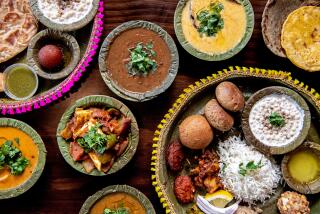Rava: Magnificent Mush
- Share via
On days such as Navroz, any well-run Parsi household is expected to produce certain basics--on the sweet side, most likely rava , a milky dish made with semolina which is often served at breakfast to get the day started properly.
There are probably as many ways to make rava as there are cooks with opinions. In general, there’s the minimalist approach, which satisfies most requirements. And then there’s my family’s version, which makes my mother smile and has made converts out of die-hards who claimed that nothing ever could be done to make something remotely edible out of the dreaded cream of wheat of their childhood. Like our invented Navroz, our rava starts out traditionally Parsi, but the end result reflects our hybrid, harum-scarum household.
BASIC RAVA
Heat 2 tablespoons or slightly less ghee or unsalted butter in heavy-bottomed saucepan. Stir in 2 tablespoons of semolina without browning. Constantly stirring, add 2 1/2 cups of milk, low fat if you want to keep things that way, extra-rich or even half-and-half if you don’t give a damn, sweeten to taste, starting with 1 1/2 tablespoons sugar. Oddly, the less sugar you use, the richer the dish seems to taste. Bring to a boil over moderate heat, stirring all the while. When the mixture reaches a boil and starts making plopping sounds, lower the heat and keep on stirring until the Rava is thick. Let the Rava cool slightly and flavor with 1/2 teaspoon vanilla or, more conventionally, a splash of rose water, the quantity to depend on you and the brand of rose water.
Turn Rava into serving dish to set to a consistency somewhere between custard and cake. Serve cool but not frigid, garnished with chopped or sliced nuts (almonds or pistachios) and raisins. Finish with a grating of nutmeg and a sprinkle of pounded cardamom seeds, the contents of 4 to 5 seed pods. Serves 6 to 8.
HERETICAL BUT GLAMOROUS RAVA
Starting with basic Rava, wait until the mixture cools slightly and tip into the bowl of a food processor with about 1/3 cup unblanched almonds. Process until the mixture smooths out and the almonds are finely chopped. Add 1/2 teaspoon of cardamom seeds crushed in a mortar and a splash of rose water. Whip 1/2 to 3/4 cup heavy cream to soft peaks and fold into lukewarm or room-temperature Rava. Pour into a serving bowl (silver if you like) and refrigerate until you want to produce dessert. Garnish with as much edible silver or gold foil as you are moved to use, a strewing of chopped pistachios, a light grating of nutmeg, and at the very last moment a scatter of dewy rose petals (unsprayed, of course). Rava is usually served on its own, but at Navroz we like it with strawberries, at other times with raspberries, sliced mangoes or blood oranges. Serves 10 to 12.
NOTES ON INGREDIENTS:
Rava is the Gujerati word for semolina, which Indian groceries sell by its more common name of sooji. Cream of Wheat (regular--not instant) will do in a pinch.
Brands of rose water vary in nature and quality. Indian rose water tends to have a peculiar undertone. I would stick with the Middle-Eastern or French brands because they have a truer rose note, and be sure you get the culinary rather than the cosmetic kind.
Edible silver foil is sold in Indian groceries. For gold, you may have to go to a framer and gilder, where you can buy booklets of leaves of pure gold. Many Indians believe in the fortifying power of ingested precious metals. Actually their benefit, if any, is in the mind’s eye.
More to Read
Eat your way across L.A.
Get our weekly Tasting Notes newsletter for reviews, news and more.
You may occasionally receive promotional content from the Los Angeles Times.










